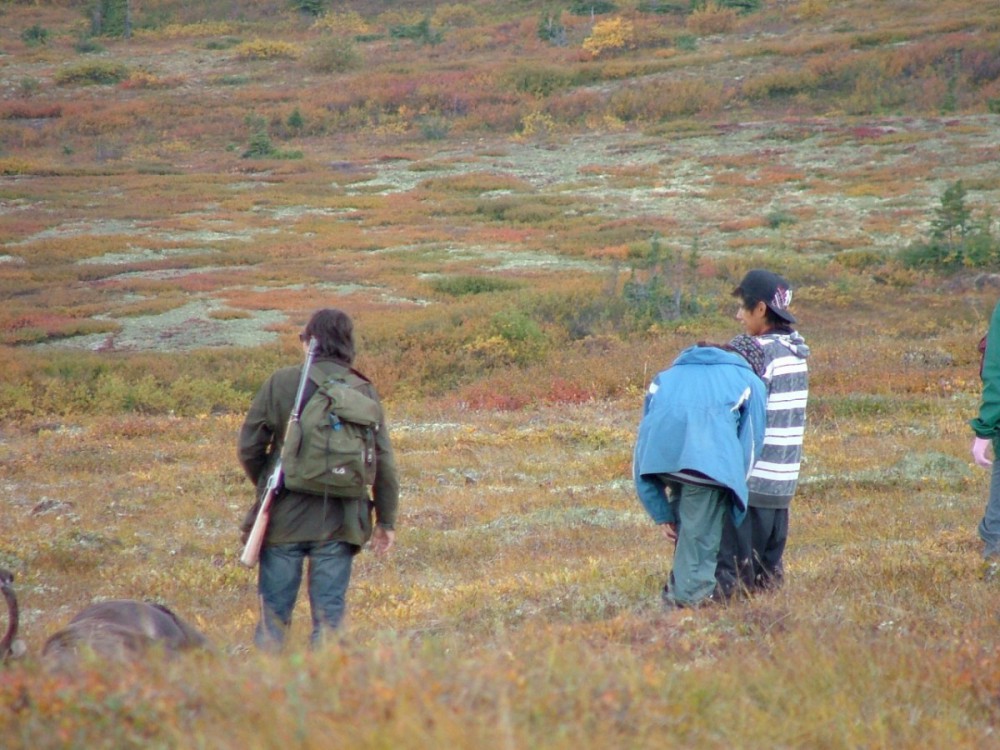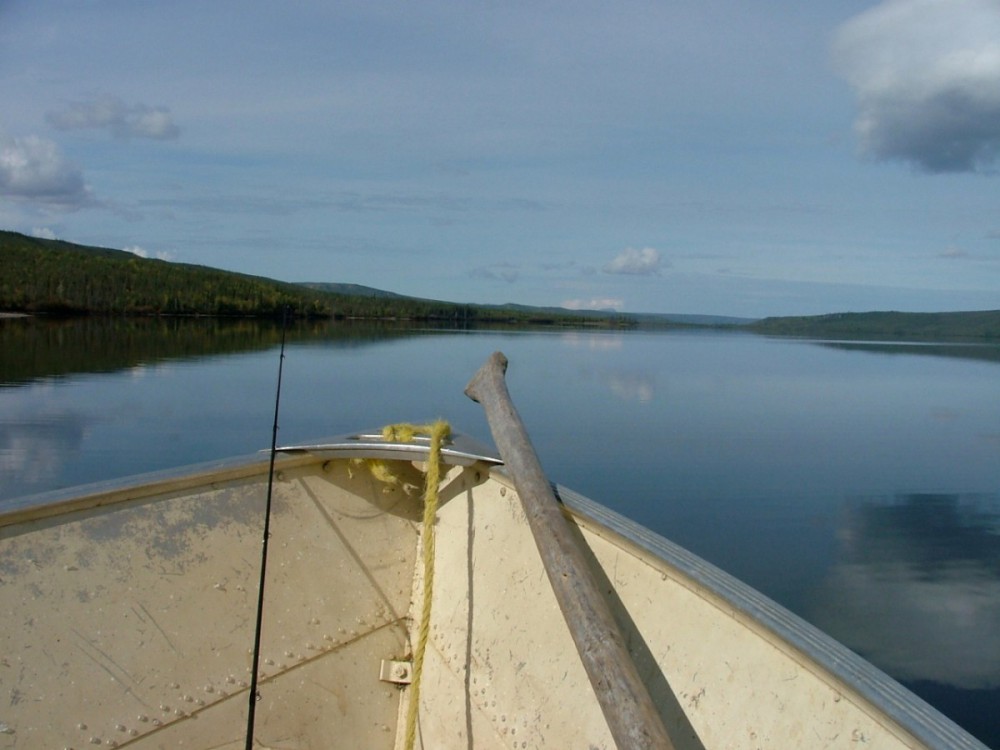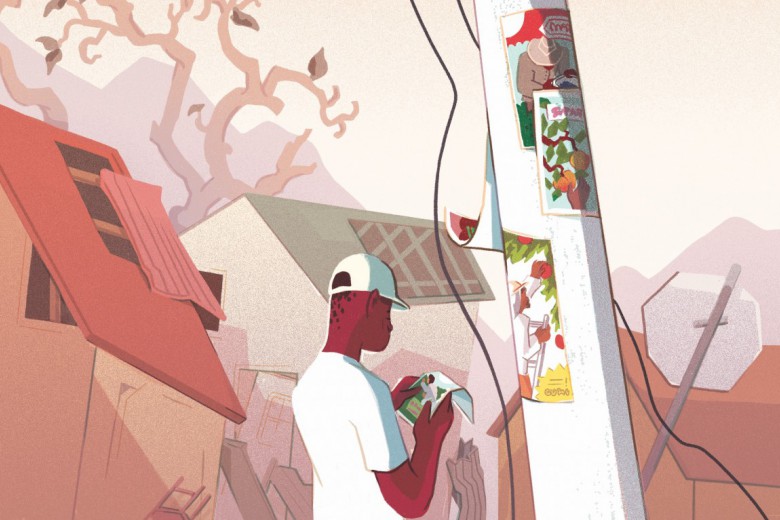
It’s late August of 2010, and I’m in the Mackenzie Mountains with Shuhtagotine (Mountain Dene) friends. After a crazy couple of hours on all-terrain vehicles – crossing a small river that’s almost deep enough to cover the tires of the little four-wheelers, and then weaving our way up the gravel, sand and rock valley – we park the quads at the foot of some hills near the source of the river. We hike up past the trees to the top of a ridge where we can find caribou. Between berry and mushroom picking, fishing, and hunting moose and caribou, our growing camp at Stewart Lake is slowly getting well-stocked with food. But on this particular day, Sean Etchinelle and I walk along the high treeless ridges without seeing any caribou.
I’ve been thinking about why I’m here. A lot of my friends are jealous of my hunting stories, and though I’ve shot caribou and Dall sheep without any qualms, I’m not a recreational hunter. I’m not here for the pleasure. I’ve been working with Begade Shuhtagotine (Mountain Dene of the Keele River area) for more than 15 years now, often spending late summer immersed in the beauty of the caribou flats in the Mackenzie Mountains, which run along the west of the mighty Deh Cho (Mackenzie River) in the Northwest Territories. These places are the hunting territories of Begade Shuhtagotine, and are known intimately to them.
The Begade Shuhtagotine are dealing with an injustice: although the government claims they are signatories to the modern Sahtu treaty, many of the Begade refused to sign and maintain they still have unsurrendered Aboriginal title to their lands. It’s a contemporary version of the Lubicon Cree story, and it shows that modern treaties are in many respects repeating the problems of earlier treaties.
I’ve been teaching and researching in Native studies at various universities for almost three decades, and Aboriginal rights have long been my passion. I’ve always felt that by going out on the land with hunters I can learn about how these big issues and policies, such as the federal comprehensive claims policy, affect people on the ground, on their ground, and give me insight into how abstract theoretical issues actually work in practice. I have been researching the United Nations Declaration on the Rights of Indigenous Peoples (DRIP), and somehow being in the mountains with these hunters gives me the time and perspective to seriously consider it. I have a wordless intuition, which worries the back of my mind.
I had always resisted working on Aboriginal rights issues at the UN level, having seen some fairly talented people working seemingly endlessly through the ’80s and ’90s with little to show for their efforts. Besides, I’ve always had a fairly strong belief that Aboriginal rights would be won or lost on the ground, at the grassroots level. So I’ve spent as much time as I can over the past three decades in small northern communities, helping build capacity and networks among those who oppose the existing policy framework. But then, after a declaration was finally passed by the UN General Assembly in 2007, I joined other Canadian allies in insisting that Canada adopt the resolution (which it did, belatedly, in 2010) without actually reading the document closely or thinking much about it.
When I did read it closely, I found that the UN DRIP is a seriously flawed legal instrument. While it offers some specific language around Aboriginal rights issues, the DRIP reflects a notion that all this time Indigenous peoples around the world have been looking for human rights rather than Aboriginal rights. And the difference between these is not merely academic. Human rights, a product of the late 18th-century Enlightenment, are rights and freedoms that human beings enjoy inasmuch as they are human. They tend to be used to protect individuals and tend to be invoked in urban contexts. Everyone, on principle, has access to them. They reflect a universalizing notion of humanity and involve equal rights and freedoms that, at a minimum, all humans should enjoy. This includes Indigenous peoples inasmuch as they, too, are human.
Aboriginal rights, by contrast, are rights that only certain people, Indigenous peoples, have, by virtue of being Indigenous. In effect, Aboriginal rights reflect a notion of cultural particularism. Indigenous cultures have become threatened as colonialism left many Indigenous peoples as a minority in their own homelands. We do not all have Aboriginal rights, nor should we. Aboriginal rights stem from the struggles of Indigenous peoples. In a way, they could be seen as a specific form of customary rights, rights that developed over time through repeated practice of an activity, rather than abstract rights that reflect a notion of how all people are the same. Aboriginal rights have tended to be asserted in rural contexts and to emphasize social collectives.
This distinction is an important one, as human rights can be used in justifying attacks on Aboriginal rights. We saw this happen in 1968-69 with the White Paper, a set of policy proposals developed by the federal government that would have done away with the Aboriginal and treaty rights of Indigenous peoples in Canada by ensuring that they would become “equal” with all other Canadians. A human right to equality became the battering ram that threatened to destroy Aboriginal rights. Indigenous peoples in Canada fought a bitter but eventually successful struggle, momentously defeating the White Paper (at least as an official policy).

In the early ’80s, when the Canadian Constitution was repatriated, Aboriginal rights were included in a general way through section 35, which said simply but powerfully that: “The existing aboriginal and treaty rights of the aboriginal peoples of Canada are hereby recognized and affirmed.” However, coming out of the White Paper struggle, leaders knew that more was needed to ensure such a proposal would never again be on the table. Another section of Canada’s Constitution, section 25, which has received little academic or legal notice, was put in place in the Charter of Rights and Freedoms. It says that the Charter will not be interpreted in any way that might “abrogate or derogate” – that is, diminish – Aboriginal rights. By doing so, Canada makes it clear that Aboriginal rights have equal legal force with human rights, which cannot be used to override Aboriginal rights.
The Supreme Court of Canada has already drawn this distinction, writing in the 1996 Van der Peet decision that “Aboriginal rights cannot, however, be defined on the basis of the philosophical precepts of the liberal enlightenment. Although equal in importance and significance to the rights enshrined in the Charter, aboriginal rights must be viewed differently from Charter rights because they are rights held only by aboriginal members of Canadian society. They arise from the fact that aboriginal people are aboriginal.”
There is no such language in the UN DRIP. In fact, most of the speeches that celebrated the passing of the DRIP tended to discuss it as an “extension” of the UN Universal Declaration of Human Rights. Extending universalism is tantamount to assimilation: it is the precise approach that Indigenous peoples have been fighting against for hundreds of years. In Van der Peet, the Supreme Court also said that an Aboriginal right protects a “… practice, custom or tradition integral to the distinctive culture of the aboriginal group claiming the right.” Aboriginal rights protect what people have done repeatedly for many years, the activities or practices that reflect and express their culture, like the hunting of Dall sheep or caribou that my Begade Shuhtagotine friends do every late summer in the mountains.
It is clear that many Indigenous peoples feel that the UN DRIP is a significant victory, and they are not wrong. The fact that the UN now has special recognition for Indigenous peoples is certainly significant. And the Canadian Constitution is not the be-all and end-all of Aboriginal rights language. Some of the detailed identification and definition of Aboriginal rights found in the DRIP would certainly give the Canadian structure more force. Still, as states around the world continue to ignore Aboriginal rights in practice, it will continue to be the strength and actions at the grassroots, community level that will determine whether Aboriginal rights are actually affirmed.
It is easier to understand this from the Mackenzie Mountains than in the boardrooms of our cities. When my Shuhtagotine friends are out in their hunting camps, they are both practicing their Aboriginal culture and exercising their Aboriginal rights. It is easier to see this relationship out on the land, where it matters, than to discuss it in seminar rooms or read about it in the technical language of lawyers and scholars.
Sean and I hear some shots. We rush down one ridge and climb more slowly up the next where we find that Sean’s dad, David, has gotten two caribou. I make tea while Sean and David butcher the caribou. A few days later I’ll make the same trip with a larger group of younger people from our camp. It is my hope that there’ll be Shuhtagotine making this trip long after my time on this earth. They’ll use different technologies, but will be hunting for the same animals in, if we leave the land intact, roughly the same places. But it won’t be the DRIP, as currently written, that’ll help them do so.



